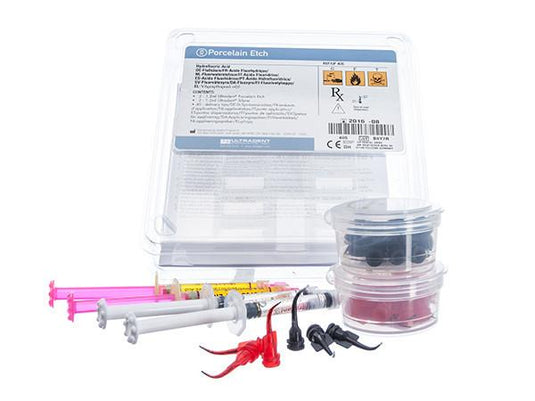
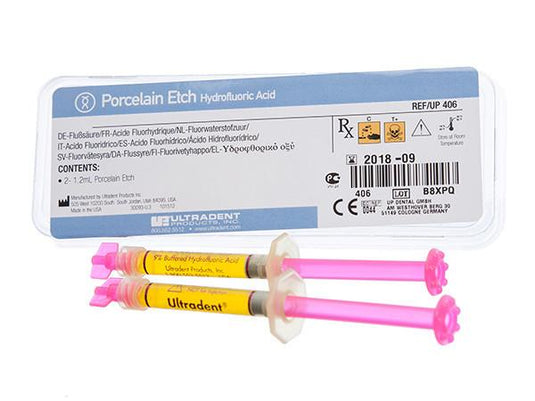
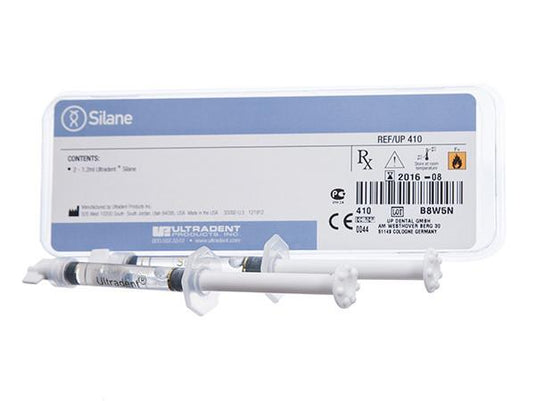

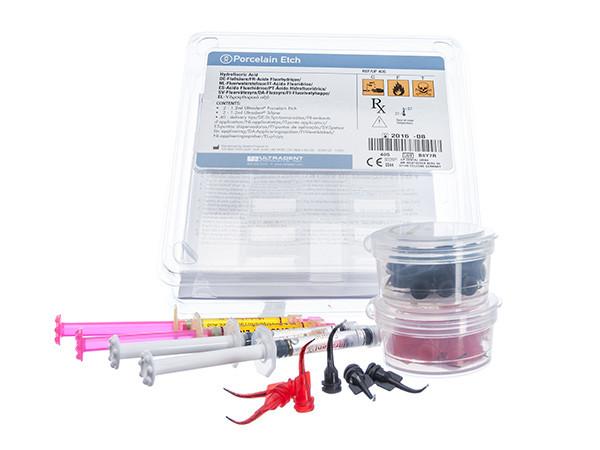
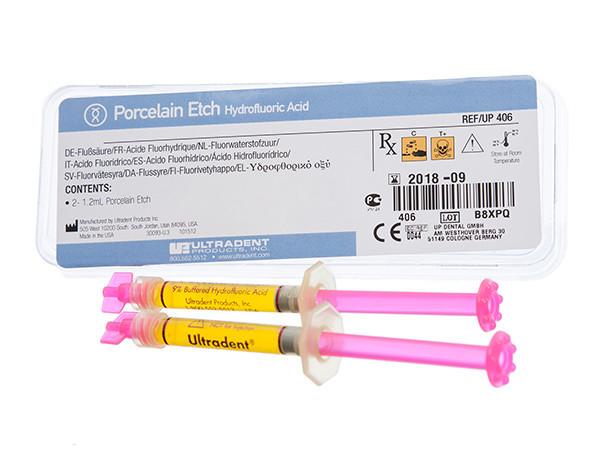
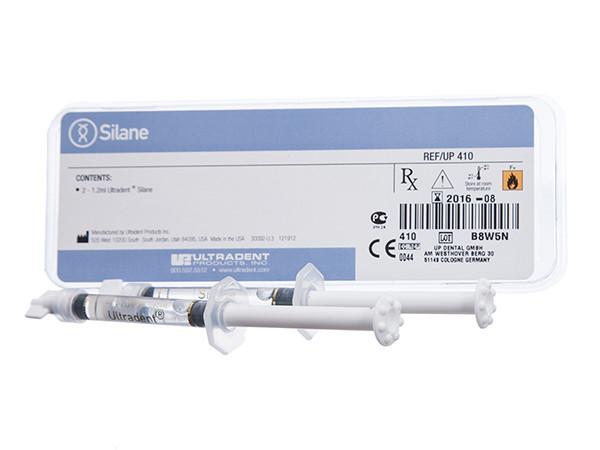
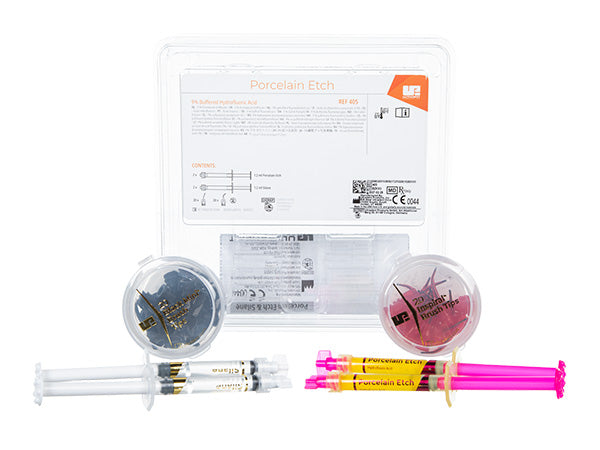
- Product Details
- Clinical Technique
- Technical Details
- Video
- Configurations
- FAQ
- Resources
- Accessories
Ultradent™ 90-second Porcelain Etch is used to etch porcelain veneers, crowns, bridges, inlays, onlays, and fractured dental porcelain. Ultradent 60-second Silane is used after hydrofluoric acid etching to prepare the surface for bonding resin.
Studies have demonstrated that Silane, when used with Porcelain Etch and a quality bonding resin, yields the highest bond strength to porcelain when compared with other porcelain bonding products.1 Both Porcelain Etch and Silane may be used intraorally or extraorally. Other features and benefits include:
- Porcelain Etch is a viscous, buffered 9% hydrofluoric acid
- Etch is easy to control and place
- Will not stain composite or resin cement
- Silane is a single-component solution
- Yields highest porcelain-to-resin bond strengths1
- Porcelain Etch and Silane may also be used on lithium disilicate (IPS e.max®2 ) restorations

Indications for Use
Porcelain Etch is designed for intraoral or extraoral porcelain etching. Use it to etch porcelain or old macrofilled composites prior to bonding.



1Pameijer CH, Louw NP, Fischer D. Repairing fractured porcelain: how surface preparation affects shear force resistance. J Amer Dent Assoc. 1996;127(2):203-9.
2Registered trademark of a company other than Ultradent.
Preparing the Porcelain
– See Instructions for Use for complete instructions, warnings, and precautions.
-
Etch clean bonding surface with Porcelain Etch for 90 seconds, rinse, and dry.

-
CLINICAL TIP: Apply phosphoric acid (Ultra-Etch etchant) for five seconds to remove porcelain salts and debris formed by hydrofluoric acid etching. Rinse and air dry.

-
Apply a puddle coat of Silane to inside surface for 60 seconds, dry, and set prosthesis aside. Do not rinse.

Penetrates Into Tubules Like No Other Sealer

Diamond-cut porcelain surface.

Same porcelain surface following a 90-second etch with Ultradent Porcelain Etch.
Viscous, Buffered 9% Hydrofluoric Acid
Porcelain Etch is a buffered, gelled hydrolic acid designed specifically to etch fractured dental porcelain and etching porcelain veneers, crowns, or inlays. It can also be used for etching porcelain crowns before bonding orthodontic brackets. It is buffered and gelled to minimize any irritation that could occur from the hydrofluoric acid vapor.
Etch is Easy to Control and Place
Porcelain Etch features a high visibility yellow hue so you can see exactly where it is placed. It is also viscous enough to stay where you place it.
Designed to Work Together
Porcelain Etch and Silane are designed to be used together when etching porcelain to provide high porcelain-to-resin bond strengths. When used with a high-quality bonding resin, Porcelain Etch and Silane can produce one of the highest porcelain-to-resin bond strengths compared to other porcelain bonding products.1
1Pameijer CH, Louw NP, Fischer D. Repairing fractured porcelain: how surface preparation affects shear force resistance. J Amer Dent Assoc. 1996;127(2):203-9.
Ultradent’s Porcelain Repair Kit contains all the products and tips needed for composite-to-porcelain, porcelain-to-metal, and porcelain-to-porcelain repairs.
Porcelain Etch Intro Kit (Item Number: 771019):
- 1 x 1.2 mL Porcelain Etch Syringe
- 1 x 1.2 mL Silane Syringe
- 10 x Black Mini Brush Tips
- 10 x Inspiral Brush Tips
Porcelain Etch Kit (Item Number: 779405):
- 2 x 1.2 mL Porcelain Etch Syringe
- 2 x 1.2 mL Silane Syringe
- 20 x Black Mini Brush Tips
- 20 x Inspiral Brush Tips
Porcelain Etch Refill (779406): 2 x 1.2 mL Porcelain Etch Syringes
Silane Refill (775410): 2 x 1.2 mL Silane Syringes
Q: When should I use Porcelain Etch and Silane?
A: Porcelain Etch and Silane can be used for etching porcelain, lithium disilicate, lithium silicate and other silica-based materials. It is not indicated for use with zirconia.
Q: Will the Porcelain Etch stain composites or resin cements?
A: No, Porcelain Etch is a predictable, stain-free chemistry designed to give high visibility without discolouring materials.
Q: Can Porcelain Etch be used intraorally?
A:Yes! Porcelain Etch is ideal for use with intraoral porcelain etching, but a rubber dam or EtchArrest must be used to protect nearby tissue and restorations.
Recommended Tips: Inspiral Brush Tips for Porcelain Etch syringes and Black Mini Brush Tips for Silane syringes.
